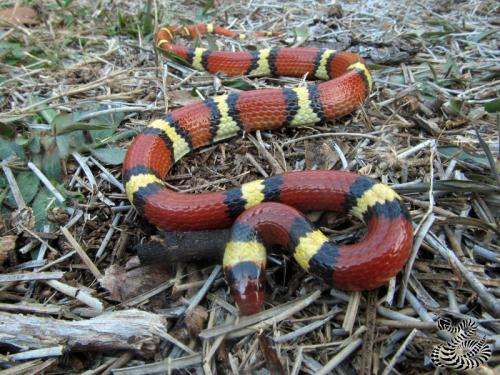Adult Scarlet King Snake, Florida Locale. Credit: G-Bartolotti/ Wikipedia SKCC BY-SA 3.0
(Phys.org) —A pair of research biologists has found that a harmless snake that mimics a dangerous snake increased its mimicry after the dangerous snake disappeared from one local area. In their paper published in the journal Biology Letters, Christopher Akcali and David Pfennig of the University of North Carolina describe their findings in studying snakes in the North Carolina Sandhills and their surprise at discovering how one adapted to the demise of the other.
Coral snakes are venomous, as most people are aware. They're also one of the more identifiable of the venomous snakes due to their unique black, yellow and red bands along the length of their body. Scarlet kingsnakes on the other hand, are not venomous. Instead they are Batesian mimics, a term used to describe harmless creatures that mimic the appearance of those that are dangerous in the hopes that they will be mistaken for them by predators and be left alone. Both types of snakes once lived in the North Carolina Sandhills area, which allowed the scarlet kingsnake to become a mimic of the coral snake. But, something unexpected happened around 1960 that caused the coral snakes to disappear from the area—no one knows why, but it left the kingsnakes without a model to copy.
With no examples to emulate, Akcali and David Pfennig figured that kingsnakes would likely have lost some of their mimicry over the past half century. To find out if they were right, the obtained samples of coral snakes captured before they disappeared and compared them with samples of kingsnakes captured at various times since then. To their surprise, they found that the sudden disappearance of the coral snake had caused the kingsnakes to look even more like them, not less.
In hindsight, the research duo suggest that had they given the situation more thought, they might have predicted what they found. They note that as the numbers of coral snakes started to decline, those kingsnakes that looked less like coral snakes likely suddenly became targets of predators, while those that looked more like the venomous snakes survived, leading to a quick evolutionary change. They suggest that the trend will not continue long, however, as time passes and predators either forget what coral snakes looked like or become bolder during lean times and overcome their fear of them.
More information: Rapid evolution of mimicry following local model extinction, Biology Letters, Published 11 June 2014 DOI: 10.1098/rsbl.2014.0304
Abstract
Batesian mimicry evolves when individuals of a palatable species gain the selective advantage of reduced predation because they resemble a toxic species that predators avoid. Here, we evaluated whether—and in which direction—Batesian mimicry has evolved in a natural population of mimics following extirpation of their model. We specifically asked whether the precision of coral snake mimicry has evolved among kingsnakes from a region where coral snakes recently (1960) went locally extinct. We found that these kingsnakes have evolved more precise mimicry; by contrast, no such change occurred in a sympatric non-mimetic species or in conspecifics from a region where coral snakes remain abundant. Presumably, more precise mimicry has continued to evolve after model extirpation, because relatively few predator generations have passed, and the fitness costs incurred by predators that mistook a deadly coral snake for a kingsnake were historically much greater than those incurred by predators that mistook a kingsnake for a coral snake. Indeed, these results are consistent with prior theoretical and empirical studies, which revealed that only the most precise mimics are favoured as their model becomes increasingly rare. Thus, highly noxious models can generate an 'evolutionary momentum' that drives the further evolution of more precise mimicry—even after models go extinct.
Journal information: Biology Letters
© 2014 Phys.org






















